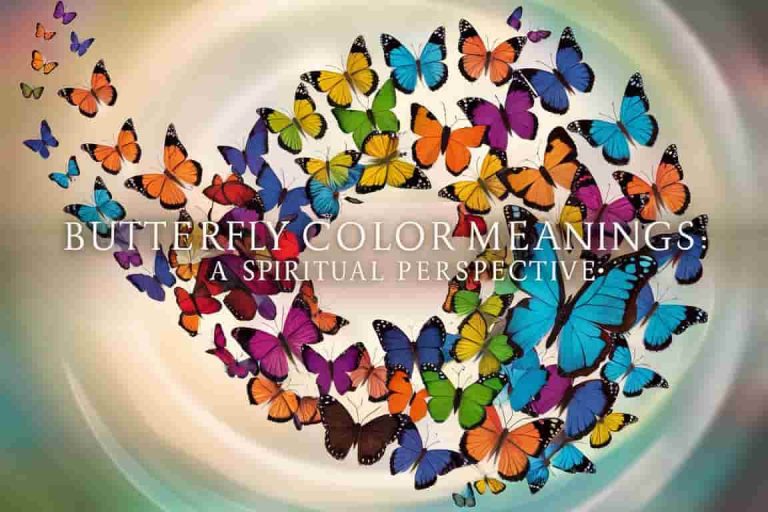Nefertiti’s Spiritual Meaning Unveiling Ancient Secrets
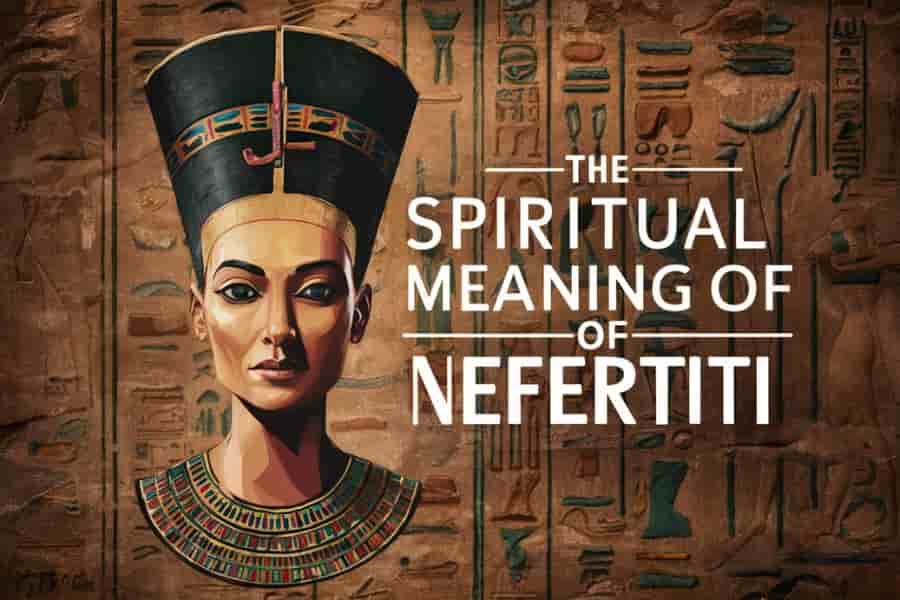
Nefertiti, the famous queen of ancient Egypt, is known for her beauty and power. But she also has a deep spiritual meaning. Her spiritual importance goes beyond her time as queen and still influences religious practices and cultural expressions today.
Nefertiti and her husband, Akhenaten, promoted the worship of Aten, the sun disc. This was a big change from worshipping many gods to worshipping only one god.Her image, especially the famous bust statue, shows grace, strength, and divine beauty.
Nefertiti was often shown in religious art, taking part in rituals and ceremonies. This highlighted her spiritual authority.
Understanding Nefertiti’s Spiritual Significance
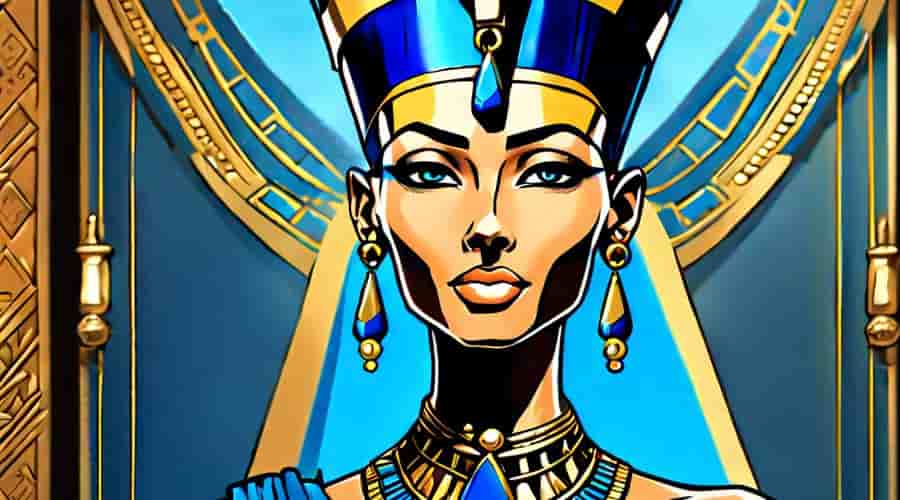
Nefertiti’s spiritual importance went beyond her role as queen. She became a symbol of divine ideals that greatly shaped the religious beliefs of ancient Egypt. Her name, “the beautiful one has come,” showed her connection to the arrival of blessings and the presence of the divine. Through her images in art and her active role in religious ceremonies, Nefertiti’s deep spiritual connection is clear.
Nefertiti’s spiritual importance can be understood through these aspects:
- Symbol of Beauty and Fertility: As the Great Royal Wife, Nefertiti represented the ancient Egyptian ideals of beauty and fertility. Her beautiful features, captured in the iconic bust, and her role as the mother of six daughters made her a living symbol of the goddesses of these virtues.
- Divine Power and Influence: Nefertiti’s presence in religious art and her participation in ceremonies usually reserved for pharaohs suggest she had significant divine power and influence. She was shown defeating enemies and performing rituals, blurring the lines between her role as queen and as a divine being.
- Connection to the Aten Cult: As an important figure in the Aten cult, Nefertiti played a key role in the religious revolution started by her husband, Akhenaten. Her images alongside the Aten and her involvement in worshipping this sun deity showed her spiritual importance in the new religion.
- Symbolic Meanings: Nefertiti’s name, her exaggerated feminine features in art, and her association with the Aten cult all contributed to her symbolic representation of divine beauty, fertility, and the regenerative power of the sun. These associations elevated her to a semi-divine status in the eyes of the ancient Egyptians.
- Lasting Legacy: Nefertiti’s spiritual influence has lasted through time, fascinating people across generations. Her iconic image and the mysteries surrounding her life have made her a symbol of ancient Egyptian spirituality, beauty, and the enduring power of the feminine divine.
Through her many spiritual meanings, Nefertiti left a lasting mark on the religious and cultural fabric of ancient Egypt. She became a legendary figure whose influence still resonates in the modern world.
Historical Context of Nefertiti’s Spiritual Role
Nefertiti’s life and reign were marked by significant events that shaped her profound spiritual influence. Understanding these pivotal moments helps us grasp the depth of her religious role.
Early Life and Marriage
The origins of Nefertiti remain shrouded in mystery. Some historians believe she was of royal lineage, while others suggest she came from a noble family. Regardless of her background, she married Akhenaten, and together they ruled over Egypt. Their partnership extended beyond mere politics into a shared spiritual vision of religious reform.
Reign and Religious Revolution
During their reign, Nefertiti and Akhenaten introduced a radical religious shift. They promoted the worship of Aten, the sun disc, over the traditional Egyptian pantheon. This move was a seismic change that reshaped the religious landscape of Egypt. Temples dedicated to other gods were closed, and new ones for Aten were constructed.
Nefertiti played a pivotal role in this revolution. She was frequently depicted alongside Akhenaten, performing religious rituals and making offerings to Aten. Her prominent involvement demonstrated her deep spiritual commitment to the new faith. This period also witnessed the creation of Amarna, a new capital city dedicated to the worship of Aten.
Later Years and Disappearance
Nefertiti’s later years remain shrouded in mystery and speculation. Some scholars believe she continued to rule after Akhenaten’s death, possibly as a co-regent. Others theorize that she may have died or been exiled from Egypt. Her abrupt disappearance from historical records has fueled countless theories and debates among Egyptologists.
| Event | Date | Significance |
|---|---|---|
| Marriage to Akhenaten | c. 1353 BC | Start of her profound influence |
| Religious Revolution | c. 1350 BC | Shift to monotheistic worship of Aten |
| Disappearance | c. 1330 BC | Mystery surrounding her fate |
Nefertiti’s life was punctuated by pivotal events that shaped her spiritual role. Her early life and marriage to Akhenaten set the stage for her influence. The religious revolution they spearheaded was a monumental turning point, elevating Nefertiti to a position of immense religious significance.
Interested in more? Read our related content.
Symbolism in Nefertiti’s Bust and Artifacts
Nefertiti’s famous bust is one of the most important artifacts from ancient Egypt. It is a beautiful work of art that shows her beauty, power, and spiritual importance. The sculptor Thutmose made the bust. It captures Nefertiti’s grace and strength. The bust is more than just art – it is a symbol of her divine status.
The Bust of Nefertiti
The bust is made of limestone and stucco. It shows Nefertiti wearing a bright blue crown. This crown is a symbol of royalty and divinity. Her slender neck and calm expression make her look graceful and beautiful. Interestingly, one of her eyes is missing. This adds a sense of mystery and suggests there may be a deeper meaning.
Other Important Artifacts
There are many other artifacts that show Nefertiti’s spiritual importance. Detailed reliefs show her taking part in religious rituals. This highlights her role as a spiritual leader. Statues often depict her with symbols of fertility and power. This emphasizes her divine status.
| Feature | Symbolism |
|---|---|
| Blue Crown | Royalty and divinity |
| Slender Neck | Grace and beauty |
| Missing Eye | Mystery and imperfection |
Nefertiti’s bust and other artifacts are full of symbolism. They reflect her spiritual significance and her role as a powerful queen. These works of art continue to fascinate people.
They offer insights into the divine status given to this mysterious figure from ancient Egyptian history.
Nefertiti’s Influence on Ancient Egyptian Religion
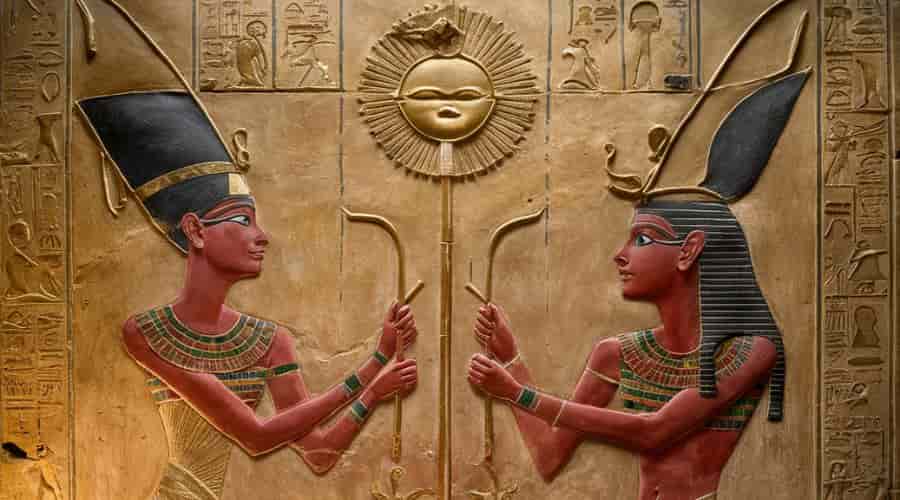
Nefertiti played a key role in transforming ancient Egyptian religion. Her influence extended beyond her lifetime, leaving a lasting impact on religious practices.
The Aten Cult
Nefertiti and Akhenaten promoted the worship of Aten, the sun disc. This was a major shift from the traditional polytheistic beliefs. Aten was seen as the sole god, representing the life-giving power of the sun. Nefertiti was often depicted worshipping Aten, highlighting her devotion.
Religious Practices and Changes
The religious changes introduced by Nefertiti and Akhenaten were significant. They closed temples dedicated to other gods and built new ones for Aten. This shift affected the entire society, changing how people worshipped and viewed the divine.
| Change | Description |
|---|---|
| Monotheism | Worship of Aten as the sole god |
| Temple Closures | Shutting down of other temples |
| New Capital | Establishment of Amarna |
Nefertiti’s influence on religion was profound. She helped shift the focus to a single god, changing the religious landscape of Egypt. Her devotion to Aten and her role in religious rituals highlight her spiritual authority.
Nefertiti as a Fertility Goddess
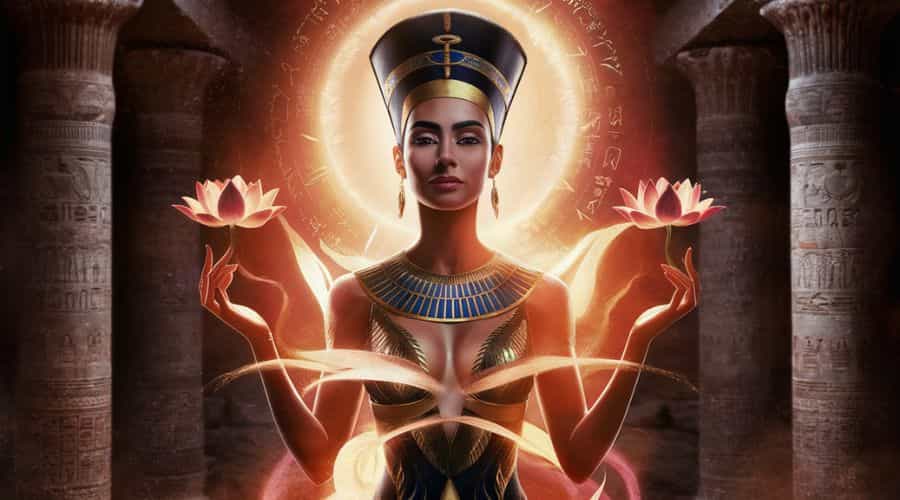
Nefertiti was often shown as a fertility goddess. This was an important part of her spiritual role in ancient Egyptian culture. Artists made images of Nefertiti with symbols of fertility. She was sometimes pictured with children or holding symbols of life. These images showed her role in promoting fertility and new life.
Nefertiti’s connection to fertility was not just symbolic. It had real meaning for her people. Fertility was very important for the survival and success of society. By representing fertility, Nefertiti showed her divine status and her importance as a source of life and growth.
- Great Royal Wife
- Lady of Grace
- Mistress of Upper and Lower Egypt
These special titles and honors given to Nefertiti show her deep spiritual importance. They are linked to her role as a fertility goddess and bringer of new
The Meaning Behind Nefertiti’s Name
Nefertiti’s name has a deep symbolic meaning. It shows her beauty and divine status. Her name means “the beautiful one has come.” It was not just a title but a symbol of her role in society.
People saw Nefertiti as a divine being who brought beauty and prosperity to Egypt. Her name had different versions that showed her connection to the god Aten and her role in the religious revolution. Some texts called her “Neferneferuaten Nefertiti.” This means “Beautiful are the beauties of Aten, the beautiful one has come.” It shows her spiritual ties to the sun disk.
- Bust of Nefertiti
- Reliefs depicting Nefertiti
- Statues and inscriptions
These famous artifacts with Nefertiti’s name and image prove the deep meaning of her name. They show her lasting legacy as a symbol of beauty, grace, and divine status in ancient Egyptian culture.
Nefertiti’s Depiction in Art and Its Spiritual Implications
Nefertiti’s depiction in art is rich with spiritual symbolism. Artists portrayed her with grace and elegance, highlighting her divine status.
Artistic Styles and Techniques
Artists used various styles and techniques to depict Nefertiti. They often showed her with a slender neck and a serene expression. These features emphasized her beauty and grace. The use of vibrant colors and intricate details added to her divine image.
Spiritual Symbolism in Art
Nefertiti’s depictions in art carried deep spiritual meanings. Her images often included symbols of fertility and power. She was shown participating in religious rituals, highlighting her spiritual authority. These artistic representations reinforced her role as a divine figure.
| Artwork | Description | Significance |
|---|---|---|
| Bust of Nefertiti | Limestone and stucco | Icon of beauty and power |
| Reliefs | Various materials | Depictions of religious scenes |
| Statues | Stone and metal | Symbol of fertility and divinity |
Nefertiti’s depiction in art is a testament to her spiritual significance. The artistic styles and symbols used to portray her highlight her divine status. These representations continue to captivate and inspire people today.
Legacy of Nefertiti’s Spiritual Influence in Modern Times
Nefertiti’s spiritual impact has gone beyond ancient Egypt. Her legacy still inspires modern art, fashion, and spiritual practices today.
Nefertiti’s image is a big influence in art and fashion. Designers and artists get ideas from her beauty and grace. They recreate her famous look in new ways. Her famous bust, with its calm face and royal style, is an iconic symbol of elegance and power. It appears in many artistic works.
Nefertiti’s role as a fertility goddess and spiritual leader speaks to modern spiritual groups. Many see her as a powerful female symbol of divine beauty. Her history as an important spiritual figure in ancient Egypt still interests people now.
- Influence on modern art
- Role in spiritual movements today
- Continued study by archaeologists
Furthermore, researchers are still very interested in Nefertiti’s life and reign. The mystery of her disappearance fascinates people. They want to find new clues about her story. Each new archaeological find or reinterpretation adds to the intriguing tale of this influential queen. It ensures her spiritual legacy lives on for generations.
Nefertiti’s influence stretches across time and cultures, leaving a lasting impact on the modern world. From artists’ canvases to spiritual seekers’ practices, her essence captivates and inspires. It shows the enduring power of her spiritual importance.
Nefertiti’s spiritual meaning is profound and enduring. She was a powerful queen and a divine figure. Her influence on ancient Egyptian religion was significant. She played a key role in the religious changes of her time.
Nefertiti’s name and depictions in art highlight her beauty and grace. Her legacy continues to inspire modern spiritual practices and cultural expressions. She remains an iconic symbol of divine beauty and power.
Nefertiti’s story is one of mystery and fascination. Her spiritual significance and enduring legacy make her a timeless figure. She continues to captivate and inspire people around the world.
Sources:






